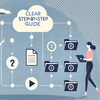
If you have seen the last season of ‘The Game of Thrones’ then you should remember why Tyrion thought it was a good idea to make Bran the King of the Seven Kingdoms. He said that Bran had the best story. And people love nothing more than a good story. While Jon Snow would argue with this whole thing, we will play along with Tyrion’s speech for the sake of this article and see what storytelling means for technical writer and whether there’s any place for it in serious technical documents.
Technical Storytelling
We should start off with this short disclaimer worthy of Captain Obvious: technical writing is a much bigger concept than user manuals. There are dozens of types of technical documentation.
Technical docs help new team members with onboarding, they lie at the root of context help as part of embedded product guides, serve as instructions for people of all ages (even for kids who just learned how to read).
Storytelling in context help is what can turn a boring ‘click here and this will happen’ into a real interactive experience for your clients. The benefits are obvious: user satisfaction, product adoption, brand loyalty, you name it!
Let’s talk about onboarding. Onboarding can define how a person feels for weeks and months to come after their employment. Sometimes it defines whether an employee stays. Neglecting this aspect will ruin employee retention rates. Remember, it is not just the new hire who should be making a good first impression, the company is just as interested in trying its best at attempting the same. Besides, efficient onboarding means the new team member is going to adapt faster and start bringing value to the company.
Wait…but how do you turn anything into a story? Here’s a simple formula that works for any type of writing, including technical writing: you need facts and they have to be plausible and authentic. For example, you can demonstrate what it is like to work in your company using a made-up character whose name is Dave. Dave is going to showcase his responsibilities in the company, his day-to-day work, company rules, etc. And, this has to look real and not like a nicer polished version of reality that has ‘fake’ written all over it. Another ingredient of a good story is emotions. Dave doesn’t have to be overly emotional, no, it is not that. But the narrative should resonate with its reader or viewer. It is supposed to make them look inside, provoke some thoughts and feelings, be relatable. And, then, supposedly, the magic is going to happen.

Can Data Scientists Tell Stories?
We can all intuitively feel when a text is good. The best ones just flow and it doesn’t matter if it is on rocket science.
Bombarding readers with facts and numbers is a poor way of data delivery, but you may wonder: what does storytelling have to do with serious scientific documentation? Isn’t this supposed to be just facts and numbers? Actually, we think that you should invite Dave to save people from being bored to death.
Data scientists are generally not good at delivering information because they have a mindset of a data scientist, not a technical writer. Technical writers are concerned not only about data, but about readers, too. So, being able to foresee how a text will be received and understood by the target audience, looking at the text message through their eyes, that’s a tech writer’s job. With such an approach, the readers won’t be bored, they will be immersed in the text with facts tailored and organized specifically for them.
Of course, there’s no room for a Dave in serious technical documents, but there are ways to make it still a good read through structure, connecting sentences and paragraphs, consistent writing style and the right choice of lexical units.
Conclusion
Creating great texts is what a good writer (technical or not) does. Even if you are merely giving instructions, you are still telling a story, leaving bread crumbs for a wanderer. You can’t turn all technical writing into something emotionality engaging, but you will be able to show the reader that you care about their journey through your careful word choice, slow and steady pace of information flow, granting a sense of security. The readers will feel that you got their back as you keep showing them relevant use cases and placing warnings exactly where they are required being proactive about possible failures. That’s how you make your tech writing story authentic and plausible, and, as far as emotions go – when you help users solve their problem, they will definitely feel gratitude.
Good luck with your technical writing!
ClickHelp Team
Author, host and deliver documentation across platforms and devices



